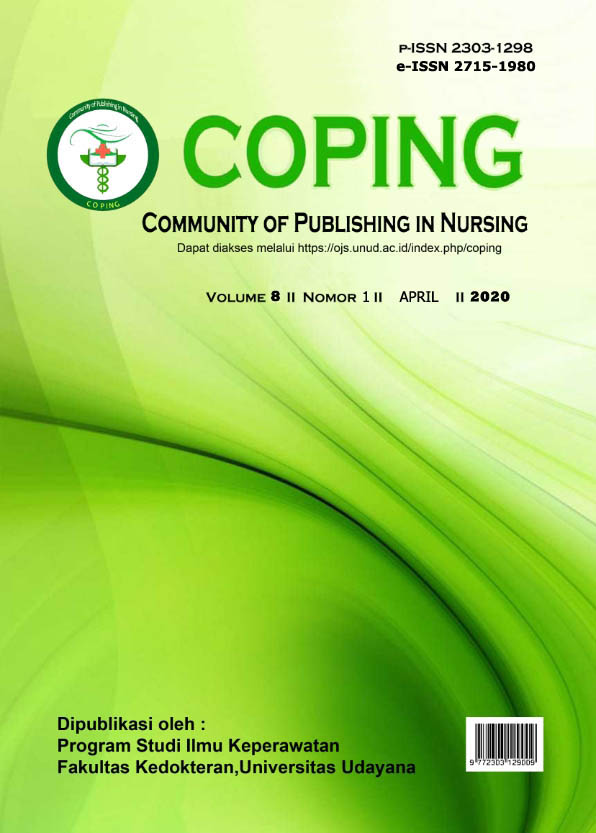Hubungan Manajemen Diabetes dengan Kejadian Luka Kaki pada Pasien Diabetes Melitus Tipe 2
Abstract
Luka kaki diabetes merupakan komplikasi serius pada diabetes melitus tipe 2. Luka kaki diabetes dapat meningkatkan risiko amputasi dan menurunkan kualitas hidup pasien. Penelitian ini bertujuan untuk menganalisis hubungan antara manajemen diabetes dengan kejadian luka kaki diabetes pada pasien diabetes melitus tipe 2. Desain penelitian ini adalah deskriptif korelasional dengan pendekatan retrospektif. Adapun jumlah sampel yang terlibat dalam penelitian ini adalah 62 pasien diabetes melitus tipe 2 yang telah memenuhi kriteria inklusi dan eksklusi. Sampel ditetapkan secara consecutive sampling. Berdasarkan hasil analisis terhadap data penelitian diketahui bahwa sebanyak 72,6% responden memiliki manajemen diabetes yang baik dan sebanyak 71% tidak mengalami luka kaki. Terdapat hubungan yang signifikan antara manajemen diabetes dengan kejadian luka kaki diabetes pada pasien diabetes melitus tipe 2 di Poliklinik Interna RSD Mangusada (nilai lambda = 0,6; p = 0.005). Hasil penelitian ini memiliki implikasi bahwa manajemen diabetes yang teratur sangat penting dilakukan oleh pasien dan perawat di Poliklinik harus memberikan edukasi kepada pasien mengenai manajemen diabetes serta luka kaki diabetes.
Kata kunci: diabetes melitus tipe 2, manajemen diabetes, kejadian luka kaki
ABSTRACT
Diabetes foot injury is a serious complication of diabetes mellitus type 2. Diabetes foot injury can increase the risk of amputation and reduce the quality of life of patients. This study aims to analyze the relationship between diabetes management and the incidence of diabetic foot injuries in diabetes mellitus type 2 patients. The design of this study is descriptive correlational with a retrospective approach. The number of samples involved in this study was 62 diabetes mellitus type 2 patients who had fulfilled the inclusion and exclusion criteria. The sample is determined by consecutive sampling. Based on the analysis of research data, it is known that 72.6% of respondents have good diabetes management and 71% do not have foot injuries. There is a significant relationship between diabetes management and the incidence of diabetic foot injuries in patients with diabetes mellitus type 2 at the Mangusada Internal Hospital Polyclinic (lambda value = 0.6; p = 0.005). The results of this study have implications that regular diabetes management is very important for patients and nurses in the Polyclinic to educate patients about diabetes management and diabetes foot injuries.
Keywords: type 2 diabetes mellitus, diabetes management, foot injury
Downloads
References
Black, J. M., & Hawks, J. H. (2009). Medical Surgical Nursing Clinical Management for Positive outcome (8th ed.). St. Louis: Elsevier Inc.
Chawla, A., Chawla, R., & Jaggi, S. (2016). Microvasular and macrovascular complications in diabetes mellitus: Distinct or continuum? Indian Journal of Endocrinology and Metabolism, 20(4), 546. http://doi.org/10.4103/2230-8210.183480
Dorresteijn, J., Kriegsman, D., Assendelft, W., Dorresteijn JAN, V. G., Dorresteijn, J. A., Kriegsman, D. M., … Valk, G. D. (2014). Cochrane Database of Systematic Reviews Patient education for preventing diabetic foot ulceration (Review) www.cochranelibrary.com Patient education for preventing diabetic foot ulceration, (12). http://doi.org/10.1002/14651858.CD001488.pub5
Eleftheriadou, Kokkinos, Liatis, Makrilakis, Tentolouris, Tentolouris, & Tsapogas. (2019). Altlas of The Diabetic Foot (3rd ed.). USA: Wiley.
Fawzy, M. S., Alshammari, M. A., Alruwaili, A. A., Alanazi, R. T. R., Alharbi, J. A. M., Almasoud, A. M. R., … Toraih, E. A. (2019). Factors associated with diabetic foot among type 2 diabetes in Northern area of Saudi Arabia: a descriptive study. BMC Research Notes, 12(1), 51. http://doi.org/10.1186/s13104-019-4088-4
Fejfarová, V., Jirkovská, A., Dragomirecká, E., Game, F., Bém, R., Dubský, M., … Wu, S. (2014). Does the diabetic foot have a significant impact on selected psychological or social characteristics of patients with diabetes mellitus? Journal of Diabetes Research, 2014, 371938. http://doi.org/10.1155/2014/371938
Hidayah, M. (2019). Hubungan perilaku self-management dengan kadar gula darah pada pasien diabetes mellitus tipe 2 di wilayah kerja puskesmas pucang sewu, surabaya. Amerta nutrition, 3(3). http://dx.doi.org/10.20473/amnt.v3i3.2019.176-182
International Diabetes Federation. (2017). Eighth edition 2017. IDF Diabetes Atlas, 8th edition. http://doi.org/http://dx.doi. org/10.1016/S0140-6736(16)31679-8.
Kurnia, A. D., Amatayakul, A., & Karuncharernpanit, S. (2017). Predictors of diabetes self-management among type 2 diabetics in Indonesia: Application theory of the health promotion model. International Journal of Nursing Sciences, 4(3), 260–265. http://doi.org/10.1016/j.ijnss.2017.06.010
Mehravar, F., Mansournia, M. A., Holakouie Naieni, K., Nasli Esfahani, E., Mansournia, N., & Almasi-Hashiani, A. (2016). The association between diabetes self-management and microvascular complications in patients with type 2 diabetes. Epidemiology and Health, e2016004. http://doi.org/10.4178/epih/e2016004
Powers, M. A., Bardsley, J., Cypress, M., Duker, P., Funnell, M. M., Fischl, A. H., … Vivian, E. (2016). Diabetes Self-management Education and Support in Type 2 Diabetes: A Joint Position Statement of the American Diabetes Association, the American Association of Diabetes Educators, and the Academy of Nutrition and Dietetics. Clinical Diabetes : A Publication of the American Diabetes Association, 34(2), 70–80. http://doi.org/10.2337/diaclin.34.2.70
Riskesdas. (2018). Riset Kesehatan Dasar 2018. Kementrian Kesehatan Republik Indonesia, 1–100. http://doi.org/1 Desember 2013
Rudianto, A. D. (2011). Konsnsus Pengelolaan dan Pencegahan Diabetes Melitus Tipe 2 di Indonesia 2011.
Timar, B., Timar, R., Schiller, A., Oancea, C., Roman, D., Vlad, M., … Mazilu, O. (2016). Impact of neuropathy on the adherence to diabetes-related self-care activities: a cross-sectional study. Patient Preference and Adherence, 10, 1169–75. http://doi.org/10.2147/PPA.S107621
Toobert, D. J., Hampson, S. E., & Glasgow, R. E. (2000). The Summary of Diabetes Self-Care. Diabetes Care Journal, 23(7), 943–950. http://doi.org/10.2337/diacare.23.7.943







